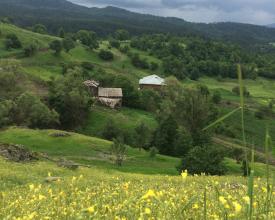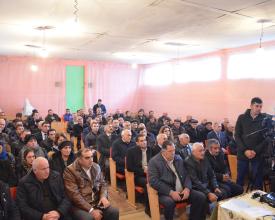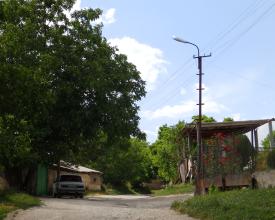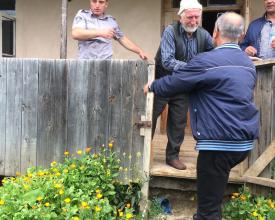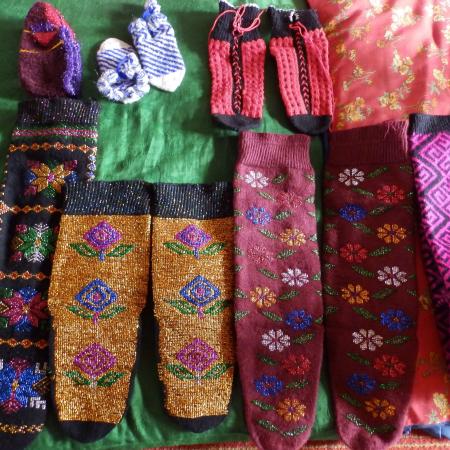
Conservación comunitaria del paisaje en Georgia
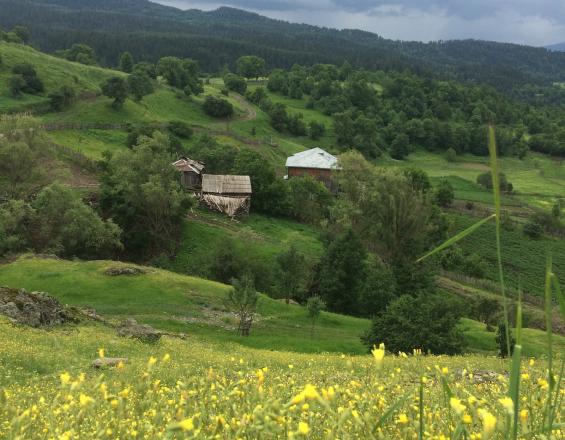
El Fondo de Ecorredores para el Cáucaso (ECF) es un instrumento de financiación que apoya la conservación comunitaria de la biodiversidad en Georgia, Armenia y Azerbaiyán. Los ecocorredores se crean conectando diversas clasificaciones de parques y zonas protegidas de los tres países. ECF utiliza acuerdos contractuales de conservación de la naturaleza y un conjunto claro de procesos para financiar el uso ecológicamente sostenible de la tierra en regiones específicas y comunidades seleccionadas de Georgia. El resultado es un mosaico interconectado de hábitats gestionados y no gestionados en diversas categorías y clasificaciones de tierras. Estos paisajes gestionados por la comunidad protegen, conectan y apoyan ecosistemas autóctonos sanos al tiempo que garantizan que la situación socioeconómica de las comunidades implicadas no se vea perjudicada ni disminuya, sino que en muchos casos mejore. ECF es una organización práctica de conservación sin ánimo de lucro financiada por el Banco de Desarrollo KfW y WWF Alemania.
Contexto
Défis à relever
Al dar a la población local la formación, la educación y el poder de decisión necesarios para participar en la gestión activa del paisaje, la ECF está proporcionando hábitats y corredores lo suficientemente amplios como para mantener poblaciones sanas de plantas y animales sin obstaculizar la economía local ni los modos de vida tradicionales. El resultado es un mosaico interconectado de hábitats gestionados y no gestionados bajo diversas categorías de tierras y estrategias de gestión, que proporcionan diversos servicios ecosistémicos, incluida una solución a la fragmentación del paisaje.
A través de la formación y la educación, la ECF está mejorando la relación y la perspectiva de la población local hacia la vida salvaje, aumentando la concienciación y fomentando el respeto y el orgullo por las especies clave. Los incentivos económicos vinculados al "Enfoque Financiero Participativo" ayudan a limitar los conflictos entre los seres humanos y la fauna salvaje al proporcionar financiación para infraestructuras básicas como el alumbrado público y las vallas eléctricas. La ECF desafía la idea de que la conservación de la naturaleza supone una pérdida de valor económico y de actividad.
Ubicación
Procesar
Resumen del proceso
Cada componente contribuye a la firma de un Acuerdo de Conservación (AC) y al plan decenal de gestión del hábitat que lo acompaña.
- Laidentificación de las áreas de conservación prioritarias determina las comunidades que pueden participar en el Enfoque Financiero Participativo (FPA).
- Laevaluación de la preparación de cada comunidad se logra mediante el Enfoque Financiero Participativo (FPA), que es una herramienta inclusiva y participativa diseñada para generar estrategias de desarrollo autónomas.
- El establecimiento de organizaciones de base comunitaria (OBC) ayuda a cada comunidad a crear una relación con la ONG local que supervisará los aspectos administrativos de una AC.
- Garantizar a la comunidadderechos de uso de la tierra a largo plazo significa que el programa local de guardabosques puede vigilar la vida salvaje, prevenir la caza furtiva y coordinar el uso sostenible de la tierra sin la obstrucción de disputas sobre el uso de la tierra.
- La firma de un Acuerdo de Conservación a largo plazo pone en uso todos los datos, la investigación y las prácticas de fortalecimiento de la comunidad de los pasos anteriores y dirige a la comunidad para alcanzar los objetos de conservación alcanzables y eficaces.
Bloques de construcción
Identificar zonas prioritarias de conservación utilizando modelos de idoneidad del hábitat para especies animales clave.
La selección de las 3 ó 4 especies animales autóctonas más representativas del paisaje ayuda a encarnar los ecosistemas específicos que necesitan protección/gestión. La identificación de las especies objetivo permite a la ECF crear un enfoque de conservación de la fauna fácil de entender para la población local -vinculando directamente una especie carismática con las prácticas de gestión del paisaje- y ayuda a proporcionar a la población local una conexión tangible entre sus esfuerzos cotidianos de conservación y los impactos a largo plazo en el paisaje. Por ejemplo, si los ecosistemas de pastizales autóctonos gozan de buena salud, el ciervo rojo del Cáucaso regresará aunque antes estuviera extinguido localmente. La presencia de estas especies animales autóctonas clave se utiliza después como indicador de biodiversidad cuando se crean los Acuerdos de Conservación.
Mediante una combinación de teledetección y datos de campo, se realiza un estudio de los hábitats existentes y potenciales de las especies clave. Mediante el programa informático MAXENT (Maximum Entropy Modeling), se crean modelos de idoneidad del hábitat para cada especie clave, lo que da lugar a mapas que muestran la idoneidad de los hábitats para las especies clave. Este planteamiento permite a los lugareños establecer una conexión clara entre los objetivos de conservación, las medidas que deben aplicarse y las repercusiones previstas, y ayuda a fijar prioridades para nuevos estudios y a supervisar las especies/hábitats.
Factores facilitadores
1. Acceso a datos actuales y precisos sobre el paisaje obtenidos por teledetección: ESRI, USGA, NOAA, etc.
2. 2. Personal formado y capacitado para utilizar SIG y programas informáticos de modelización.
3. 3. Combinación de datos y conocimientos locales y especializados sobre especies clave.
4. Acceso a datos de campo de ONG que trabajen o hayan trabajado en la región.
Lección aprendida
- La modelización de la idoneidad de los hábitats ofrece un método rentable y rápido para establecer prioridades geográficas y temáticas de conservación dentro de un paisaje complejo.
- Incluso con una disponibilidad limitada de datos de observación sobre el terreno, los resultados son útiles en las fases iniciales de planificación, aunque hay que tener en cuenta las limitaciones de la calidad de los datos de entrada.
- Los mapas de idoneidad de los hábitats representan una buena base para debatir los objetivos, las prioridades y las medidas de conservación con las distintas partes interesadas, incluida la población local.
Herramienta de Enfoque Financiero Participativo (FPA)
El Enfoque Financiero Participativo (EFP) de ECF es una metodología que utiliza subvenciones financieras directas para movilizar a las poblaciones locales para que se hagan cargo de su propio desarrollo. Está diseñado para generar estrategias de desarrollo autónomo que sean constructivas, inclusivas y muy participativas a nivel familiar, comunitario y regional.
Los concursos de relatos, organizados por ONG locales de todo el Corredor Occidental del Cáucaso Menor, ayudan a describir la relación entre la población local y las principales especies de animales salvajes seleccionadas para representar mejor los paisajes y encarnar los ecosistemas que necesitan protección/gestión. A continuación se llevan a cabo actividades destinadas a mejorar simultáneamente los hábitats animales y los medios de subsistencia humanos, en paralelo con modelos de idoneidad de los hábitats. El proceso FPA ayuda a desarrollar una relación positiva y basada en la confianza entre ECF y la población local.
La participación en un ACA conduce al desarrollo del contrato de conservación a largo plazo de ECF (Acuerdo de Conservación) y anima a la población local a convertirse en responsables de la toma de decisiones y administradores de los recursos naturales, al tiempo que fomenta un sentimiento de orgullo/protección de las especies silvestres clave. Los ACA también abordan cuestiones subyacentes de tenencia de la tierra/uso de la tierra que representan motores de los problemas de conservación (es decir, caza furtiva, uso insostenible/ilegal de los recursos).
Factores facilitadores
- Disponibilidad de ONG locales con experiencia y capacidad para facilitar procesos comunitarios
- Apoyo de las autoridades locales y otras instituciones a través de grupos de trabajo regionales
- Establecimiento de una conexión entre las costumbres tradicionales, los patrones de comunicación, la toma de decisiones y la metodología moderna, al tiempo que se fomentan los valores culturales y tradicionales existentes.
- Aplicación de incentivos financieros sin condiciones
- Proporcionar capacitación y formación a la carta para responder a las nuevas necesidades de las comunidades locales.
Lección aprendida
- Los incentivos financieros incondicionales atraen el interés inicial por el proyecto y más tarde generan orgullo, satisfacción y motivación en la comunidad después de que los incentivos se utilicen para mejorarla.
- La metodología de los APC requiere un ajuste a la finalidad y los objetivos de cada proyecto.
- La ejecución de pequeños proyectos gestionados por la comunidad es clave para determinar qué comunidades están comprometidas y son competentes para entablar una cooperación a más largo plazo.
- La incorporación de los conocimientos tradicionales a los modelos y estrategias modernos crea una fusión de contribuciones basadas en la ciencia y en la comunidad.
- Los problemas de tenencia de la tierra se identifican pronto y permiten a ECF evaluar la viabilidad de los proyectos.
- Introducción de estructuras básicas de la sociedad civil mediante la creación de comités de aldea, grupos de trabajo regionales autocoordinados, seguimiento periódico de los proyectos y reuniones anuales.
Creación de organizaciones de base comunitaria (OBC)
La creación de un CBO es el paso intermedio entre el proceso del FPA y la firma de un Acuerdo de Conservación. Las OCB se crean con la orientación de la ECF y son responsables de:
i) la obtención y aplicación de un Acuerdo de Conservación
ii) la distribución justa y equitativa de los beneficios entre la comunidad
iii) actuar como la entidad legal que representa a la comunidad en un Acuerdo de Conservación.
Las OBC se constituyen con arreglo a la legislación nacional adecuada a su finalidad, país y región. Si no es posible crear una OBC, una ONG puede actuar como tal en el Acuerdo de Conservación.
Para crear una OC es necesario que la comunidad local asuma un compromiso de cooperación a largo plazo y se responsabilice de las acciones de conservación. De este modo, la OC contribuye a reforzar el capital social y a aumentar las prácticas sostenibles de uso de la tierra. Las organizaciones comunitarias de base contribuyen a reforzar las conexiones, la comunicación y la capacidad de recuperación de la comunidad en relación con los esfuerzos de conservación de la naturaleza. Se anima a las organizaciones comunitarias de base a considerar la biodiversidad como parte de la economía local y a colaborar estrechamente con la ECF para acordar un uso sostenible de la tierra. Se anima a las organizaciones comunitarias de base a buscar otras fuentes de financiación para proyectos comunitarios y a desarrollar sus actividades como un negocio sostenible durante el periodo de aplicación del Acuerdo de Conservación.
Factores facilitadores
- Se inicia o refuerza la autoorganización de las comunidades a través del ACA
- Negociación de los términos con los representantes de la comunidad para establecer un Acuerdo de Conservación claro y a largo plazo
- Diálogo, negociación y participación con todos los segmentos de la comunidad: ancianos, responsables de la toma de decisiones, miembros influyentes de la comunidad, mujeres y jóvenes
- Identificar e incluir a todos los grupos de usuarios de una comunidad: pastores, agricultores, cazadores, curanderos
- Participación de las autoridades locales (por ejemplo, el departamento forestal)
- Compromiso estratégico con las instituciones regionales y nacionales
Lección aprendida
- La falta de gobernanza a nivel comunitario, la falta de concienciación medioambiental y las interacciones negativas con la fauna salvaje exigen campañas de educación/concienciación comunitaria.
- Los pequeños proyectos dirigidos a nivel local fomentan la capacitación de la comunidad, la comunicación y la aplicación de estrategias de conservación.
- La creación de organizaciones comunitarias representa un avance del APF y una mejora cualitativa en términos de autoorganización local.
- No imponga un modelo de organización a la comunidad local; decídalo conjuntamente.
- El desarrollo de capacidades relacionadas con la gestión y la gobernanza de las OC es fundamental para garantizar el éxito inicial y reducir la dependencia del apoyo externo.
- La participación de la OC en la adquisición y organización de la información de base sobre cuestiones relacionadas con los medios de subsistencia, los recursos naturales y el uso de la tierra garantiza la información pertinente y contribuye al desarrollo de la capacidad de la OC.
- La aceptación de las opiniones de los miembros de la comunidad a la hora de diseñar los objetivos del proyecto garantiza que éste sirva a toda la comunidad.
- La participación de los gobiernos locales vincula las aplicaciones de la gestión basada en los ecosistemas a temas más amplios como el cambio climático y la reducción del riesgo de catástrofes.
Garantizar los derechos de uso de la tierra a largo plazo para la comunidad y los objetivos de conservación
La propiedad clara de la tierra y su tenencia (el derecho a utilizarla) son las condiciones previas básicas para la aplicación de cualquier medida de gestión del hábitat. Los derechos de uso de la tierra de todos los beneficiarios deben estar claros y asegurados antes de que comiencen las iniciativas del proyecto para evitar el riesgo de dimensiones no documentadas en la planificación y aplicación de medidas de conservación. También garantiza el interés a largo plazo del usuario de la tierra por gestionarla de forma sostenible. El objetivo de esta medida es aclarar, regular legalmente, obtener y mantener los derechos de tenencia de la tierra necesarios para las acciones de conservación y para un medio de vida sostenible. Los derechos de tenencia de la tierra abarcan la propiedad de la tierra, el arrendamiento de la tierra y/u otros derechos relacionados con el uso de la tierra.
En Georgia, la mayor parte de la tierra es propiedad del Estado. Pero tras la desintegración de la Unión Soviética, los derechos de tenencia de la tierra no han sido debidamente documentados ni registrados. Hoy en día, los derechos tradicionales de uso de la tierra basados en acuerdos verbales y tradiciones se traducen en arrendamientos legalmente documentados/registrados por las organizaciones comunitarias que representan a sus respectivos pueblos. Resolver la incertidumbre sobre la tenencia de la tierra es uno de los principales beneficios que la ECF está aportando a las comunidades asociadas, proporcionándoles una perspectiva económica clara para el futuro y preservando al mismo tiempo la actual gestión comunitaria de los pastos y prados compartidos.
Factores facilitadores
- Preparación de las autoridades estatales de la propiedad para documentar y registrar los derechos comunitarios de uso de la tierra existentes
- Realización de un estudio sobre la tenencia de la tierra para comprender las incertidumbres sobre la tenencia de la tierra y los derechos existentes
- Elaboración de mapas precisos de toda la zona de conservación y comunicación de estos resultados (mapas, cifras, informes) accesibles a la comunidad y las autoridades
- Participación activa de los gobiernos locales (a nivel municipal y departamental)
- Implicación voluntaria de las autoridades, departamentos y administración locales
- Compensación adecuada por el uso del suelo
Lección aprendida
- Identificar adecuadamente los derechos de uso del suelo y las cuestiones pendientes, incluyendo la investigación, la recopilación de datos y el análisis SIG realizado i) formalmente (recopilación de datos municipales y regionales), y ii) informalmente (conversaciones con la población local).
- Consideración de la documentación de la información y de la falta de documentación. La población local puede utilizar los pastos/praderas de forma tradicional, con poca o ninguna documentación sobre sus derechos de uso. En el marco del proyecto, el uso de la tierra debe considerarse tanto en contextos formales/políticos como informales/tradicionales.
- Comunicación entre los múltiples organismos de gestión de la tierra en Georgia (estatales, municipales, comunitarios, privados) y las designaciones del uso de la tierra (bosques, agricultura, áreas protegidas, tierras privadas). Las relaciones positivas y la comunicación activa con todas las partes interesadas conducen a unas relaciones de trabajo saludables.
- La consideración de la política nacional y regional es esencial para garantizar los derechos de uso del suelo.
- Presupuestación suficiente de los costes necesarios para obtener los derechos de uso de la tierra.
Creación de un programa local de guardabosques
Para llevar a cabo eficazmente las medidas de conservación, los proyectos requieren personas dedicadas, capacitadas y formadas sobre el terreno y en la comunidad. La ECF consideró que la creación de un programa de guardas locales denominado "cuidadores" era un paso importante para garantizar el cumplimiento de los objetivos de conservación sobre el terreno y su comprensión en la aldea. Los cuidadores son personas de la zona que conocen y comprenden su entorno local, saben comunicarse con los habitantes y los visitantes y están motivados para proteger la naturaleza. Se les identifica a través del proceso del AAP y posteriormente son contratados por las OC. Se les forma en métodos de conservación, se les dota de equipos de comunicación, uniformes y, a veces, medios de transporte, pero no tienen los derechos legales del personal (gubernamental) de las áreas protegidas ni de los guardas forestales. Pueden informar y educar a la población y denunciar las infracciones a las autoridades competentes. Los cuidadores colaboran en el seguimiento de la biodiversidad, educan y sensibilizan a la población y realizan tareas de gestión de las AC. Son responsables de la recogida de datos, el seguimiento continuo de la fauna y la presentación de informes de progreso a la ECF. Los cuidadores son un punto de contacto clave (de confianza y respetado) en la comunidad, y actúan como ejemplo de los beneficios socioeconómicos de la conservación de la naturaleza.
Factores facilitadores
- Una selección prudente significa que las personas elegidas son de confianza, tienen capacidad para aprender nuevas habilidades, apertura para aceptar nuevas ideas y responsabilidad para informar/llevar a cabo los objetivos
- Implicación de los cuidadores en todos los aspectos del desarrollo de capacidades con las instituciones y autoridades locales implicadas en la gestión de la tierra y la conservación de la naturaleza, incluidas las agencias forestales, los municipios, etc.
- Participación en sesiones de formación en las que se utilicen las herramientas/habilidades requeridas para el puesto, así como fomento de una fuerte ética, honestidad y compromiso con los objetivos de conservación de la naturaleza.
Lección aprendida
- La emigración de los jóvenes es un obstáculo para encontrar un cuidador adecuado para los objetivos y la aplicación del proyecto a largo plazo.
- Educar a las comunidades en prácticas y aplicaciones de gestión basadas en el ecosistema pondrá en tela de juicio las perspectivas anteriores sobre la vida salvaje, al tiempo que demostrará cómo la conservación puede beneficiar a la comunidad y fomentará el respeto por el puesto de cuidador.
- Las autoridades locales y las organizaciones comunitarias son débiles desde el punto de vista institucional, por lo que se fomenta el fortalecimiento institucional general y el desarrollo de capacidades.
- El papel de los cuidadores es inicialmente malinterpretado por las autoridades locales y locales. Se requiere esfuerzo y entrenamiento para establecer la comprensión de que la vigilancia y la aplicación de la ley representan sólo una parte menor del ámbito de trabajo de los cuidadores y que el énfasis principal debe estar en la sensibilización, el suministro de información y orientación, y el liderazgo dentro de la comunidad local.
- Garantizar que los cuidadores reciben educación y formación significa que se puede acceder a las herramientas y recursos empleados y utilizarlos.
Compromiso con objetivos de conservación explícitos y alcanzables mediante acuerdos de conservación a largo plazo
Los Acuerdos de Conservación (AC) son contratos de subvención vinculantes creados y acordados por comunidades específicas y la ECF. Los AC fijan objetivos de conservación claros, alcanzables y realistas y determinan el alcance de las medidas de conservación que se aplicarán en las comunidades que demuestren tener la organización, la motivación y el compromiso necesarios para seguir planes decenales de gestión del hábitat. Los objetivos de conservación los determinan la ECF y la comunidad local utilizando conocimientos especializados y locales. Cada acuerdo se adapta a las necesidades identificadas en la comunidad objetivo y el paisaje local. Estos contratos obligan a las comunidades a proteger los ecosistemas, pero también ayudan a los usuarios tradicionales de la tierra a utilizarla de forma sostenible.
Las comunidades que firman los Acuerdos de Conservación han sido seleccionadas para ello porque demuestran iniciativa, implicación comunitaria y potencial a través del proceso FPA y el establecimiento de una CBO. Para garantizar la sostenibilidad de los proyectos, se supervisa el cumplimiento de los Acuerdos de Conservación. Cada comunidad debe presentar informes técnicos anuales. En caso de que no lleven a cabo las actividades previstas, los pagos del acuerdo pueden suspenderse hasta que cumplan los requisitos, o rescindirse posteriormente si no cumplen durante más de un año.
Factores facilitadores
- Aplicación con éxito del FPA; las comunidades practican el uso de herramientas, modelos, financiación
- Desarrollo de una filosofía de apoyo y educación, no de vigilancia.
- Selección cuidadosa de las comunidades que demuestren tener las capacidades, la organización y la implicación necesarias para iniciar medidas de conservación
- Proporcionar formación y educación para tomar decisiones y gestionar los paisajes en cooperación con los ideales de conservación de la naturaleza
- La definición clara de las actividades remuneradas crea un sentido de finalidad para las organizaciones comunitarias.
- Ayudar a las comunidades a conseguir financiación adicional
Lección aprendida
- En muy pocos casos se necesitan conocimientos técnicos para cuestiones específicas relacionadas con la aprobación de planes de gestión del hábitat.
- Las estimaciones de costes se elaboraron en colaboración con los representantes de las comunidades locales basándose en su conocimiento de los mercados locales. El resultado final es que los acuerdos de conservación fijan un reembolso de costes total justo que permite a las OC aplicar los acuerdos de conservación y garantizar su sostenibilidad económica durante el periodo contratado.
- Los informes comunitarios anuales incluyen: una comparación de los valores previstos y reales de las medidas planificadas; la evolución de los plazos del proyecto; un informe financiero general; información sobre problemas e identificación de posibles soluciones.
- Cada año se selecciona una muestra de acuerdos de conservación para que ECF o un tercero realice una auditoría independiente de los resultados. Esta es una oportunidad para examinar el seguimiento y la presentación de informes como método para comprobar el rendimiento del proceso de los acuerdos de conservación.
- Examinar las conexiones entre el objetivo de conservación y la resiliencia/medios de vida de la población local ayuda a orientar futuros proyectos.
Impactos
La ECF está mejorando la conectividad de los hábitats en el Cáucaso combinando los conocimientos locales y la acción comunitaria con datos científicos y prácticas modernas de gestión del uso del suelo. La creación de corredores ecológicos enlaza parques y zonas protegidas, contribuyendo a la conservación de la biodiversidad dentro y fuera de las zonas protegidas y a través de las fronteras nacionales. El "Enfoque Financiero Participativo" es un planteamiento basado en la comunidad que funciona en paralelo con los modelos de paisaje. Este proceso ayuda a la ECF a identificar a las comunidades que están dispuestas a comprometerse con los objetivos de conservación y, al mismo tiempo, a desarrollar una relación basada en la confianza. Este es el primer paso hacia un "Acuerdo de Conservación " y tiene efectos positivos que capacitan a la población local para convertirse en responsables de la toma de decisiones y administradores de los recursos naturales, al tiempo que desarrollan el orgullo y la protección de especies clave. La mejora de la productividad pastoral y agraria y los incentivos financieros fomentan la unión de la conservación y el bienestar de la comunidad. Los acuerdos de conservación recompensan y capacitan a la población local para preservar la naturaleza y la cultura local, lo que lleva a la creación de organizaciones de conservación de base comunitaria y planes sostenibles de uso de la tierra que tienen en cuenta la biodiversidad y la economía local. Se aplican procesos de seguimiento específicos, incluida la asignación de "cuidadores " que vigilan/siguen los movimientos de la fauna salvaje y hacen cumplir las leyes contra la caza furtiva.
Beneficiarios
Aldeas beneficiarias:Dertseli, Mokhe, Naminauri, Tsikhisubani
Otros pueblos beneficiarios: Didi Zanavi, Patara Zanavi, Gomaro, Nakurdevi, Khevasheni, Bolajuri, Kvemo Enteli, Chorchani, Didi Smada, Patara Smada, Tsre, Pkhero, Shoka, Zemo Enteli, Kikibo.
Objetivos de Desarrollo Sostenible
Historia

La región de Adigeni, en Georgia , es conocida por sus monasterios históricos y su antigua metalurgia. Dehrseli es una pequeña comunidad de la región que fue identificada como candidata al programa de la ECF. Hace más de un año, la comunidad tomó parte en el Enfoque Financiero Participativo (FPA) de ECF, un proceso que ayuda a la administración de ECF a evaluar si una comunidad está abierta y es capaz de comprometerse con un Acuerdo de Conservación. Zaza Shavadze es un respetado líder comunitario en Dertseli y miembro de la junta de la Unión Comunitaria de Dertseli. Su familia y su comunidad son un ejemplo de los efectos positivos del programa de la ECF.
El FPA ofrece un incentivo económico a una comunidad como recompensa por tomar medidas específicas que la preparen para suscribir un Acuerdo de Conservación en el futuro. Algunas de estas medidas incluyen la creación de una colaboración con una ONG o institución asociada para supervisar los avances, el desarrollo de una capacidad de liderazgo comunitario y la garantía de que haya una participación de la comunidad a múltiples niveles, desde los escolares hasta los responsables de la toma de decisiones de la comunidad. La dotación económica no está sujeta a ningún parámetro y la comunidad puede utilizar el dinero para cualquier fin, desde la instalación de alumbrado público hasta la mejora del estado de las carreteras. Algunas comunidades, como Dehrseli, se han visto alentadas por el aumento del turismo en la zona y están trabajando para crear más oportunidades económicas relacionadas con el turismo. Un grupo de mujeres de la comunidad de Dehrseli ha empezado a fabricar calcetines que venden a los turistas y en los mercados locales.
La herramienta FPA ayuda a desarrollar un nivel de confianza entre la comunidad y ECF, demostrando que ECF no trata de vigilar o reducir las actividades económicas relacionadas con el uso de la tierra, sino de fomentar una asociación basada en la amistad y la confianza en la que el bien de la comunidad se integra en los objetivos de conservación de la vida salvaje. El objetivo de la ECF en su conjunto es contribuir a la conservación ecológica en el Cáucaso sin reducir los ingresos de las poblaciones rurales, y el FPA ha demostrado ser un peldaño clave para alcanzarlo.

